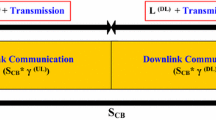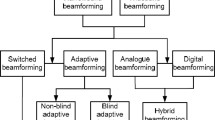Abstract
Long Term Evolution - Advanced (LTE-A) supports closed-loop Multiple Input Multiple Output (MIMO) techniques to improve its performance, but in order to exploit multiuser (MU) MIMO channel capabilities, the design of an efficient Medium Access Control (MAC) scheme that supports MU-MIMO is still an open issue in the literature. This paper proposes a novel energy efficient MAC scheme for LTE-A, which aims to achieve simultaneous downlink transmissions to multiple users, through the deployment of a low complexity beamforming technique at the physical layer. Our proposed scheme takes advantage from the multiuser gain of the MIMO channel and the multiplexing gain of the Multibeam Opportunistic Beamforming (MOB) technique, to improve the system throughput and the energy efficiency of wireless networks. We provide a closed form mathematical expression of the energy efficiency, where the results from the proposed scheme achieve a considerable energy saving at the Base Station (eNB).




Similar content being viewed by others
Notes
Even the beams (b) are orthogonal but their flows in the channel (h b) are not orthogonal [11].
References
Larmo A et al (2009) The LTE link-layer design. IEEE Commun Mag 47(4):52–59
Zhang L, et al (2014) Quality of service modelling of virtualized wireless networks: a network calculus approach. Springer Mobile Networks and Applications 19(4)
Astely D, et al (2009) LTE: the evolution of mobile broadband. IEEE Commun Mag 47(4):44–51
Ekstrom H, et al (2006) Technical solutions for the 3G long-term evolution. IEEE Commun Mag 44(3):38–45
Mustaqim M, et al (2012) LTE-Advanced: requirements and technical challenges for 4G cellular network. CIS J 3(5)
Zhang H, et al (2012) MIMO downlink scheduling in LTE systems, IEEE INFOCOM 2012, pp 2936–2940
Li Q et al (2010) MIMO techniques in WiMAX and LTE: a feature overview. IEEE Commun Mag 48(5):86–92
Kwan R, Leung C (2010) A survey of scheduling and interference mitigation in LTE. J Electr Comput Eng 2010(1)
Samarasinghe T, et al (2011) The feedback-capacity tradeoff for opportunistic beamforming. IEEE ICC, Kyoto
Sharif M, Hassibi B (2005) On the capacity of MIMO broadcast channel with partial side information. IEEE Trans Inform Theory 51(2)
Zorba N, Perez-Neira AI (2007) CAC for multibeam opportunistic schemes in heterogeneous WiMax systems under QoS constraints. IEEE Globecom, New Orleans
Vereecken W, et al (2011) Power consumption in telecommunication networks: overview and reduction strategies. IEEE Commun Mag 49(6):62–69
Althunibat S, et al (2013) Energy optimization in multiuser quantized feedback systems. EURASIP J Wirel Commun Netw 83
Xie R, Yu FR, Ji H (2013) Interference management and power allocation for energy-efficient cognitive femtocell networks. Springer Mobile Networks and Applications 18(4)
Bousia A, et al (2012) Green distance-aware base station sleeping algorithm in LTE-advanced. IEEE ICC, Ottawa
Zhang X, et al (2013) Energy-efficiency study for two-tier heterogeneous networks (HetNet) under coverage performance constraints. Springer Mobile Networks and Applications 18(4)
Huang J, et al (2012) A close examination of performance and power characteristics of 4G LTE networks, Proceeding MobiSys ’12, New York, pp 225–238
3GPP TS 36.213 (2014) Evolved universal terrestrial radio access (E-UTRA) physical layer procedures. Rel 12
Gesbert D, et al (2006) Transmit correlation-aided scheduling in multiuser MIMO networks. IEEE ICASSP
Viswanath P, et al (2002) Opportunistic beamforming using dumb antennas. IEEE Trans Inform Theory 48:1277–1294
Saha S, Quazi R (2009) Priority-coupling-a semi-persistent MAC scheduling scheme for VoIP traffic on 3G LTE. 10th International Conference on Telecommunications, pp 325–329
Shamshad F, et al (2012) Physical layer aspects of 3GPP’s long term evolution (LTE). Advances in Computer Science and its Applications (ACSA) 2(1)
3GPP TS 36.212 (2014) Evolved universal terrestrial radio access (E-UTRA); Multiplexing and channel coding. Rel 12
Tran T, et al (2012) Overview of enabling technologies for 3GPP LTE-advanced. EURASIP J Wirel Commun Netw 2012 (1)
3GPP TS 36.211 (2014) Evolved universal terrestrial radio access (E-UTRA) radio physical channels and modulation. Rel 12
Acknowledgments
This work has been partially funded by the Research Project Qatar University SG-CENG-DEE-13/14-3
Author information
Authors and Affiliations
Corresponding author
Rights and permissions
About this article
Cite this article
Imran, R., Shukair, M., Zorba, N. et al. An Energy Saving Strategy for LTE-A Multiantenna Systems. Mobile Netw Appl 20, 692–700 (2015). https://doi.org/10.1007/s11036-015-0599-y
Published:
Issue Date:
DOI: https://doi.org/10.1007/s11036-015-0599-y




